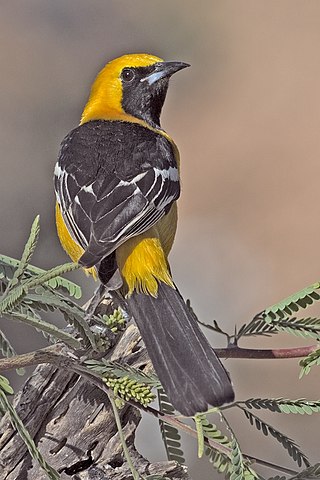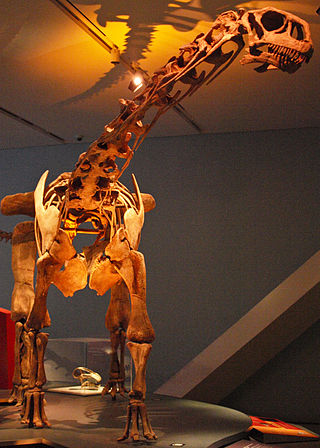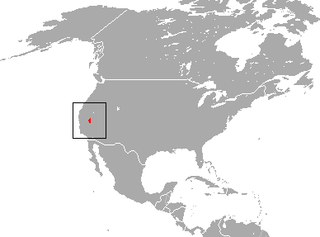
The hooded oriole is a medium-sized New World oriole. The male of this species ranges in color from a bright orange to a paler yellow, with a black back, face, tail and bib, with the wing containing two white bars. The female is more of an olive color with some yellow accents.

A field guide is a book designed to help the reader identify wildlife or other objects of natural occurrence. It is generally designed to be brought into the "field" or local area where such objects exist to help distinguish between similar objects. Field guides are often designed to help users distinguish animals and plants that may be similar in appearance but are not necessarily closely related.

Gregory Scott Paul is an American freelance researcher, author and illustrator who works in paleontology. He is best known for his work and research on theropod dinosaurs and his detailed illustrations, both live and skeletal. Professionally investigating and restoring dinosaurs for three decades, Paul received an on-screen credit as dinosaur specialist on Jurassic Park and Discovery Channel's When Dinosaurs Roamed America and Dinosaur Planet. He is the author and illustrator of Predatory Dinosaurs of the World (1988), The Complete Illustrated Guide to Dinosaur Skeletons (1996), Dinosaurs of the Air (2001), The Princeton Field Guide to Dinosaurs (2010), Gregory S. Paul's Dinosaur Coffee Table Book (2010), The Princeton Field Guide to Dinosaurs: 2nd Edition (2016), The Princeton Field Guide to Pterosaurs (2022), The Princeton Field Guide to Mesozoic Sea Reptiles (2022) and editor of The Scientific American Book of Dinosaurs (2000).

Minmi is a genus of small herbivorous ankylosaurian dinosaur that lived during the early Cretaceous Period of Australia, about 120 to 112 million years ago.

Malawisaurus is an extinct genus of titanosaurian sauropod dinosaur. It is known from the Dinosaur Beds of northern Malawi, which probably date to the Aptian stage of the Early Cretaceous. The type species is M. dixeyi and the specific name honours Frederick Augustus Dixey.

Shunosaurus, meaning "Lizard from Sichuan", is a genus of sauropod dinosaur from Late Jurassic (Oxfordian) beds in Sichuan Province in China, from 161 to 157 Million years ago. The name derives from "Shu", an ancient name for the Sichuan province.

The bare-backed rousette is a species of megabat.

Microcleidus is an extinct genus of sauropterygian reptile belonging to the Plesiosauroidea. The species has 40 neck vertebrae and a short tail of 28 vertebrae. Fossils of the genus have been found in France, the Posidonia Shale in Germany and Luxembourg, and the Alum Shale Formation of England.
Leonard Joseph Victor Compagno is an international authority on shark taxonomy and the author of many scientific papers and books on the subject, best known of which is his 1984 catalogue of shark species produced for the Food and Agriculture Organization (FAO) of the United Nations. Compagno was mentioned in the credits of the 1975 film Jaws along with the National Geographic Society.

Turiasaurus is a genus of sauropod dinosaurs. It is known from a single fossil specimen representing the species Turiasaurus riodevensis, found in the Kimmeridgian Villar del Arzobispo Formation of Teruel, Spain.

The Mount Lyell shrew is a species of mammal in the family Soricidae. It is named for Mount Lyell in Yosemite National Park, the area where the shrew has been most commonly found.

Mauritia is a genus of fan palms which is native to northern South America and to the Island of Trinidad in the Caribbean. Only two species are currently accepted.

Dakotadon is a genus of iguanodont dinosaur from the Barremian-age Lower Cretaceous Lakota Formation of South Dakota, USA, known from a partial skull. It was first described in 1989 as Iguanodon lakotaensis, by David B. Weishampel and Philip R. Bjork. Its assignment has been controversial. Some researchers suggest that "I." lakotaensis was more basal than I. bernissartensis, and related to Theiophytalia, but David Norman has suggested that it was a synonym of I. bernissartensis. Gregory S. Paul, working on a revision of iguanodont species, gave "I." lakotaensis its own genus (Dakotadon) in 2008. He measured its length at 6 metres (20 ft) and body mass at 1 metric ton.
Andrew James Henderson is a palm-systematist and Curator of the Institute of Systematic Botany at the New York Botanical Garden. He has authored taxonomic descriptions of 140 species, subspecies and varieties of plants, especially in the palm family
Levnesovia is a genus of hadrosauroid dinosaur from the Late Cretaceous Bissekty Formation of Uzbekistan. It was related to Bactrosaurus. The type species is L. transoxiana. The genus name honours the late Russian paleontologist Lev Nesov, and the specific name refers to the ancient region Transoxiana. It is known from the minority of the skull and would have reached around two meters in length.

Zanabazar is a genus of large troodontid dinosaurs from the Late Cretaceous of Mongolia. The genus was originally named by Rinchen Barsbold as the new species Saurornithoides junior. In 2009 it was reclassified as its own genus and species, Zanabazar junior, named after Zanabazar, the first spiritual figurehead of Tibetan Buddhism in Mongolia. The holotype includes a skull, vertebrae, and right hindlimb. Zanabazar was one of the largest and most derived troodontids.

Marquand Park is a 17-acre (69,000 m2) arboretum and recreational area located in Princeton, New Jersey. It contains walking paths, a baseball field, and attractions for children such as a sandbox and a play structure.

The Princeton Field Guide to Dinosaurs is a reference work on dinosaurs written by the paleontologist and paleoartist Gregory S. Paul. It was first published by Princeton University Press in 2010. In the United Kingdom it was published by A & C Black under the title Dinosaurs: A Field Guide. An updated second edition was released in 2016. A third edition is set to release in 2024.

Tambatitanis is an extinct genus of titanosauriform dinosaur from the Early Cretaceous of Japan. It is known from a single type species, Tambatitanis amicitiae, which is known from the Sasayama Group. It was probably around 14 m (46 ft) long and its mass was estimated at some 4 tonnes. It was a basal titanosauriform and possibly belonged to the Euhelopodidae. The holotype was collected between 2006 and 2010.
Spilomyia foxleei is a species of syrphid fly in the family Syrphidae.















